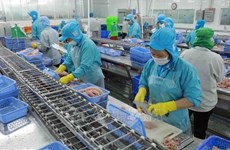Ninh Thuan province develops grape eco-system
The south-central province of Ninh Thuan has introduced new grape varieties and advanced farming techniques to improve farmers’ incomes.
 Tourists visiting a grape orchard in Ninh Hai district’s Vinh Hai commune in Ninh Thuan province. (Photo: VNA)
Tourists visiting a grape orchard in Ninh Hai district’s Vinh Hai commune in Ninh Thuan province. (Photo: VNA)The country’s largest grape producing province has more than 1,000ha under the fruit and an annual output of 26,000-28,000 tonnes, according to its Department of Agriculture and Rural Development.
It grows mostly two table varieties, Red Cardinal and NH 01-48, and the wine grape Syrah.
To add value, the province has developed models of growing high quality grape to Vietnamese and global good agricultural practices (VietGAP and GlobalGAP), and organic standards, and used advanced farming techniques in recent years.
Some 31 per cent of the grape growing area sees the use of advanced techniques such as automatic irrigation and polygreen houses, and quality standards like VietGAP and GlobalGAP, according to the department.
The local Nha Ho Research Institute for Cotton and Agriculture Development has created many new grape varieties like NH 01-152 and NH04-102.
Table grape variety NH 01-152 has a weight of 500-800 grammes per bunch, is wine red in colour, has slightly sweet and crunchy flesh, and an average annual yield of 12-16 tonnes per hectare.
The institute is providing the variety to farmers and cooperatives to replace some degenerated ones.
Traders buy NH 01-152 in orchards at a price of 100,000-120,000 VND (4.2-5.1 USD) a kilogramme, three or four times the price of Red Cardinal and two to three times that of NH 01-48.
Phan Cong Kien, deputy head of the institute, said the institute has also created the seedless variety NH04-102, also called black finger grape, and provided it for farmers to grow on an experimental basis.
It could be used to make raisins, he added.
Many farmers are growing new varieties in hi-tech polygreen houses, and they are very popular with consumers.
The province plans to expand its grape growing area to 1,115ha and annual output to 27,652 tonnes this year, and to 1,770ha by 2025, including 1,070ha grown to VietGAP, GlobalGAP or organic standards.
It is creating favourable conditions for farmers to tie up with cooperatives and companies to develop value chains for grapes and grape products.
Dang Kim Cuong, director of the Department of Agriculture and Rural Development, said the province has taught farmers techniques for preserving grapes and creating facilities for drying and storing them.
It has assisted establishments with making products from the fruit such as jams, raisins, wines, and syrups, he said.
It is developing more grape-related products and offering tourism services at orchards.
Visitors to orchards can harvest grapes, eat them and buy fresh fruits and products made from them.
Thai An grape village in Ninh Hai district’s Vinh Hai commune has become a popular tourism destination.
Pham Thi Dung, who has a 4,000sq.m grape orchard in the village, said she grows four table grape varieties to serve tourists.
She also sells products such as raisins, syrups, wines, and juices, she said.
“To have beautiful looking and even-sized grapes, my family has adopted VietGAP standards, reducing the use of chemical pesticides and fertilisers to make the grape plants grow well and offer high yields.”
Nguyen Khac Phong, director of the Thai An General Agriculture Cooperative in Vinh Hai commune, said members grow 20ha of NH 01-152 grape, which has been recognised as a four-star product under the national “One Commune- One Product” (OCOP) programme.
The cooperative also has five three-star OCOP products made from grapes, including wines and raisin.
Nguyen Van Hoa, director of the province Department of Culture, Sport and Tourism, said the eco-tourism model of visiting grape orchards is developing rapidly in Ninh Hai, Ninh Phuoc and Ninh Son districts, helping diversify tourism products.
The department has taught orchard owners how to serve tourists, he said.
Many owners have invested in tourism facilities to attract tourists./.













